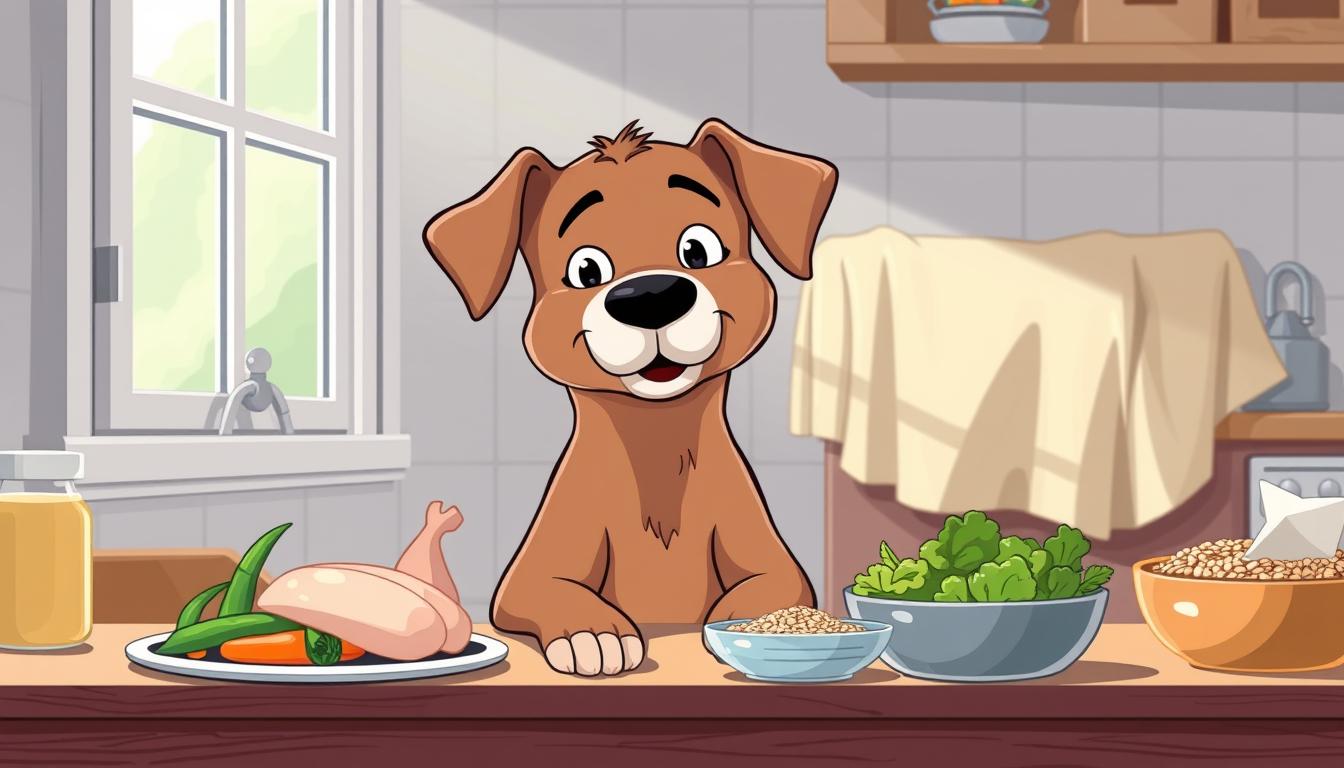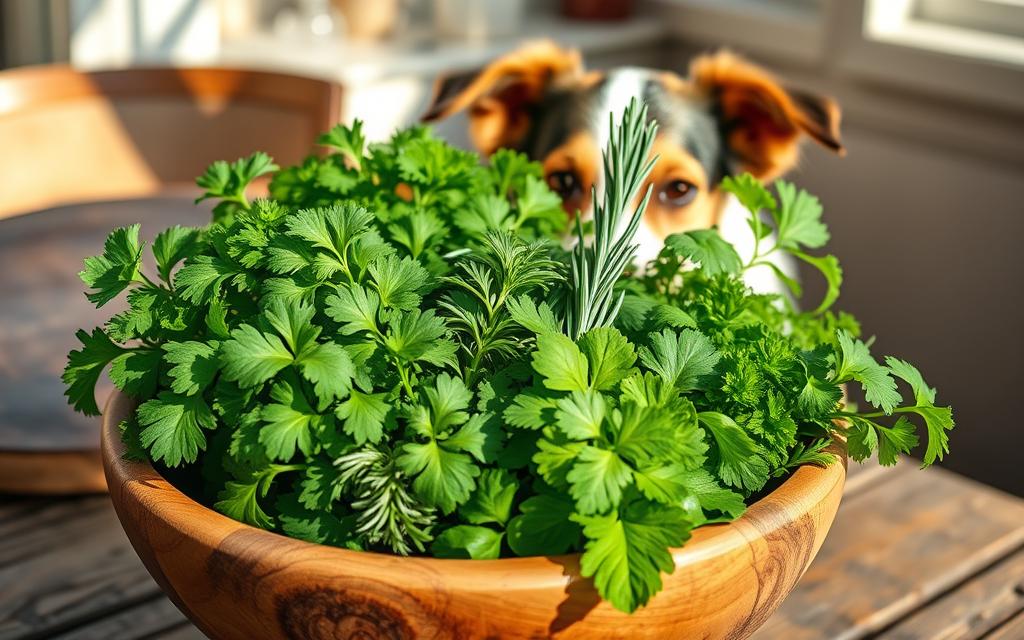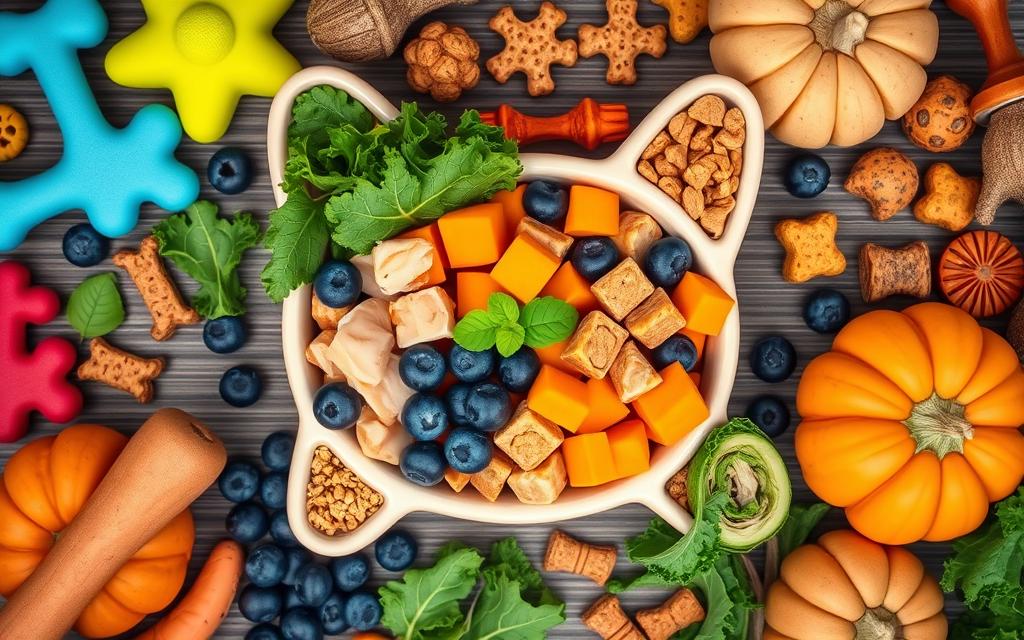As a dog owner, you want the best for your pet, even after surgery or illness. The right food is key for their recovery. It’s important to know how to feed them to help them get better fast.
After surgery, dogs often don’t want to eat. If they miss meals for over 24 hours, they can start to feel worse. A vet can suggest a diet rich in fat, but it must be tailored to your dog’s surgery.
With the right food and care, your dog can recover quickly and feel better soon.
Key Takeaways
- Proper nutrition is essential for post-surgery dog nutrition and feeding sick dogs.
- A high-fat diet can be beneficial, but a personalized diet is recommended.
- Highly digestible ingredients and energy-rich food are crucial for a recovering dog.
- Smaller, lighter meals may be beneficial, and access to fresh clean water is essential.
- Wet food can be a good choice for dogs during recovery, providing protein and fat for energy.
- Consulting a veterinarian is vital for creating a tailored diet and feeding regime for your dog.
- Feeding strategies, such as warming up food or hand-feeding, can make meals more enticing and comfortable for a recovering pet.
Understanding the Importance of Post-Recovery Nutrition
When your dog is recovering from surgery or illness, it’s key to know about post-recovery nutrition. Your dog needs certain nutrients to heal and get strong again. A good dog recovery nutrition plan can greatly improve their health and happiness.
A post-surgery dog diet should give the right nutrients for healing, immune support, and energy. This diet should include lean proteins, complex carbs, and healthy fats. Foods like boiled chicken, turkey, or lean beef, and cooked veggies like carrots and sweet potatoes, are great choices.
How Recovery Affects Your Dog’s Dietary Needs
Recovery changes your dog’s diet needs. You might need to feed them smaller, more frequent meals. This helps their digestive system. Foods like plain rice and pumpkin can also help with digestion.
The Role of Nutrition in Healing
Nutrition is crucial for healing. A good post-surgery dog diet supports recovery. Foods rich in omega-3s, probiotics, and antioxidants help with inflammation, healing, and immune function.
Why Traditional Feeding Methods May Need Adjustment
Traditional feeding might not be enough during recovery. You might need to adjust your dog’s diet. Talking to your vet can help create a personalized dog recovery nutrition plan. This plan will meet your dog’s specific needs and help them recover faster.
Immediate Post-Surgery Feeding Guidelines
After your dog’s surgery, it’s key to feed them the right food. Your vet will tell you the best meals for your pup’s recovery. Feeding dog after surgery needs careful thought to make sure their digestive system can handle it.
When it comes to post-op dog care, following your vet’s advice is crucial. Each dog needs a different diet because of the vitamins lost after surgery. Special foods made for pets are gentle on their stomachs and help them recover.
Here are some tips for feeding your dog after surgery:
- Keep a 1:1 ratio of cooked protein and carbohydrate for home-cooked meals.
- Avoid giving your dog their favorite snacks, as they may not be easily digestible after surgery.
- Consider using critical care diets, which are highly palatable, digestible, and nutritionally dense.
Remember, every dog is unique, and your vet may suggest a specific diet or medication. By following their advice and giving the right food, you can help your dog recover quickly and comfortably.
What to Feed Your Dog After Surgery or Illness
When your dog is recovering from surgery or illness, it’s crucial to feed them the right foods. These should be easy to digest and full of nutrients. Start with a small amount of bland food like boiled chicken or rice to ease their stomach.
Lean proteins, cooked veggies, pumpkin, and rice are great for sick dogs. They’re gentle on the stomach and can help prevent nausea and vomiting. Adding a bit of bone broth or Greek yogurt can also boost their nutrition and gut health.
Easily Digestible Food Options
- Boiled chicken or turkey
- Cooked white rice
- Pumpkin
- Green beans
- Sweet potatoes
Introduce new foods slowly and in small amounts to avoid upsetting your dog’s stomach. Watch their appetite and adjust feeding times as needed. If you’re unsure, always ask your vet for specific advice.
Recommended Portion Sizes
The right portion size depends on your dog’s size, age, and activity level. Start with small amounts (about 1/4 cup) and increase as their appetite grows. Always follow your vet’s feeding advice to ensure your dog gets the nutrients they need.
| Dog Size | Portion Size |
|---|---|
| Small | 1/4 cup |
| Medium | 1/2 cup |
| Large | 3/4 cup |
Special Dietary Considerations for Different Types of Surgery
When caring for your dog after surgery, it’s key to think about their diet. Different surgeries need specialized post-surgery dog diets for a safe recovery. For example, dogs with dental surgery should eat soft foods to avoid pain.
Dogs with abdominal surgery might need a surgery-specific dog nutrition plan. This plan includes a diet that’s easy on their stomach. It has the right mix of fiber and omega-3 fatty acids to help them heal. Important things to consider in post-surgery diets include:
- High-energy foods that meet their needs without being too much
- Foods with omega-3 fatty acids, amino acids, and prebiotics for recovery
- Watching how much food they eat and adjusting as needed
It’s vital to talk to your vet about the best specialized post-surgery dog diets for your dog. They can help pick the right foods, how much, and when to eat. Following a surgery-specific dog nutrition plan helps your dog heal faster and lowers the chance of complications.

Managing Your Dog’s Appetite During Recovery
When your dog is recovering from surgery or illness, watching their appetite is key. It’s normal for them to eat less, but they still need nutrients for healing. To help, try warming their food, giving them smaller meals, and adding tasty things like bone broth.
Here are some ways to help your dog’s appetite during recovery:
- Start with a light meal after surgery to get them interested in food
- Stay away from heavy or rich foods that might upset their stomach
- Choose foods that are easy to digest so your dog can get the nutrients they need
- If your dog still won’t eat, talk to your vet for advice
Remember, every dog is unique and recovers differently. If your dog hasn’t eaten in 24 hours after surgery, see your vet. This can help your dog feel better and recover faster.
Here’s a quick guide to help manage your dog’s appetite during recovery:
| Strategy | Description |
|---|---|
| Warm Food | Warm your dog’s food to make it more appealing |
| Smaller Meals | Offer smaller, more frequent meals to ease digestion |
| Enticing Additions | Add ingredients like bone broth to make meals more enticing |
Transitioning Back to Regular Food
When your dog gets better from surgery or illness, it’s key to slowly add regular food back. This helps avoid stomach problems. Start by mixing a bit of regular food with their recovery food. Then, slowly add more regular food over time.
Watch for signs your dog is ready for regular food. Look for a bigger appetite, more energy, and normal poop. But, watch them closely and adjust the food mix if needed. How long it takes to get back to normal food can vary, based on how sick they were.
Step-by-Step Transition Process
To make the transition smooth, follow these steps:
- Check with your vet to know when to start adding regular food.
- Start with 25% regular food and 75% recovery food.
- Slowly add more regular food over 7-10 days, watching your dog’s health.

Keep an eye on your dog’s hunger, energy, and poop during this time. If they show signs of upset stomach, like throwing up or diarrhea, talk to your vet. They can help adjust the food mix.
| Day | Percentage of Regular Food | Percentage of Recovery Food |
|---|---|---|
| 1-3 | 25% | 75% |
| 4-6 | 50% | 50% |
| 7-10 | 75% | 25% |
| 11+ | 100% | 0% |
By following these steps and talking to your vet, you can help your dog smoothly go back to their regular diet. This will help them get back to full health.
Common Feeding Challenges and Solutions
When your dog has surgery, they might face feeding problems. These can include not wanting to eat, trouble swallowing, or upset stomachs. For example, about 30% of pets might not eat the day of surgery. But, they should start eating again the next day without throwing up.
After surgeries like removing foreign bodies, dogs usually stop throwing up in one to three days. To help with these issues, try these tips:
- Offer small, frequent meals to ease digestion
- Provide a quiet, comfortable eating area to reduce stress
- Monitor your dog’s condition and consult your veterinarian if symptoms persist
Keep an eye out for signs of trouble, like pale gums. This could mean your dog is losing blood or has poor circulation. Or, if gums look bluish-purple, it might mean they’re having trouble breathing. If you see these signs, get your dog to the vet right away. By knowing these signs and taking action, you can help your dog recover well and deal with any eating problems.
Every dog recovers differently. It’s key to follow your vet’s advice on feeding and care. This will help your pet get the best care possible.
Supplements and Additional Nutritional Support
When your dog is recovering from surgery or illness, supplements play a big role. They help fill nutritional gaps and support a smooth recovery. For example, post-surgery dog vitamins can reduce inflammation and boost the immune system.
Omega-3 fatty acids and probiotics are great for recovery. Omega-3s reduce inflammation, and probiotics help with digestion. Fish oil is also beneficial for reducing inflammation and supporting recovery. Always talk to your vet before adding supplements to your dog’s diet.
Natural immune boosters like antioxidants and vitamin E are also helpful. You can find them in foods like sweet potatoes and carrots or in supplements. A balanced diet and the right supplements can greatly improve your dog’s recovery. Working with your vet and choosing the right supplements can help your dog heal faster and better.
Key Considerations for Supplementing Your Dog’s Recovery
- Consult with your veterinarian before adding any supplements to your dog’s diet
- Choose high-quality supplements specific to dogs
- Keep an eye on your dog’s progress and adjust supplements as needed
By carefully choosing supplements for your dog’s recovery, you can ensure they get the nutrients they need to heal and thrive.
Signs of Dietary Problems During Recovery
When caring for your dog after surgery, watch for dog recovery red flags like vomiting, diarrhea, or no appetite. If your dog shows these signs, get vet help fast to fix post-surgery nutrition issues.
Look out for these important signs:
- Inability to urinate or have a bowel movement within 48 hours of surgery
- Vomiting or diarrhea that lasts more than 24 hours
- Lethargy or depression that lasts more than 24 hours
- Loss of appetite that lasts more than 24-48 hours
Also, check the incision site for infection signs like redness, swelling, or discharge. If you see these, call your vet right away.
Knowing these dog recovery red flags and acting quickly helps your dog recover safely. It also helps fix any post-surgery nutrition issues that come up.
Working with Your Veterinarian on Dietary Plans
When your dog is recovering from surgery, working with your vet is key. They can give you veterinary nutrition advice that fits your dog’s needs. This includes their health, weight, and what they should eat.
A good post-surgery dog care plan includes what to feed your dog. Your vet can suggest the best foods, like proteins and vitamins. Together, you can make a plan that helps your dog get better.
Some important things to talk about with your vet are:
- Feeding schedules and portion sizes
- Recommended food types and supplements
- Monitoring progress and addressing potential complications
Following your vet’s advice and keeping in touch is crucial. Keep track of your dog’s progress. This info will help your vet in future visits.
Conclusion
As your dog recovers, remember that good food is key to their healing. By following the advice in this article, you can help your dog get back to full strength. With patience and the right food, your dog will get better.
Keep a close eye on your dog, work with your vet, and be ready to change things if needed. The post-recovery dog care and successful dog surgery recovery tips here will help you feed your dog right. Take this journey together, and you and your dog will face any challenges and come out stronger.




